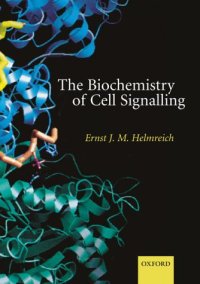
Ebook: Biochemistry of Cell Signalling
Author: Ernst J. M. Helmreich
- Genre: Biology // Biochemistry
- Tags: Биологические дисциплины, Биохимия, Биохимия мембран и рецепторов
- Year: 2001
- Publisher: Oxford University Press
- Edition: 1
- Language: English
- djvu
The Biochemistry of Cell Signalling deals in depth with the principles of cell signalling, concentrating on structure and mechanism. It will serve as a reliable map through the maze of cell signalling pathways and help the reader understand how malfunctions in these pathways can lead to disease. The book is divided into four parts. Part 1 describes the machinery of signal transduction starting with the properties of signals, receptors (including receptor activation), regulators, and the molecules that link receptor and regulator. The design of signalling cascades is explained by describing central signalling pathways: the Ras-regulated MAPK and PI-3 pathways; the Rho/Rac/Cdc 42 pathway controlling chemotaxis and regulating the cytoskeleton; the G protein coupled receptor cascades in response to sensory and hormonal signals; signalling by TGF-ss in morphogenesis; cytokine signalling that controls haemopoiesis. There is also a discussion of the insulin response. As phosphorylation - dephosphorylation is involved in nearly all cellular regulatory processes, Part 1 concludes with a synopsis of its role in signalling. Part 2 describes the implementation of the signalling cascades focusing on the effect on gene transcription. After a brief description of the transcriptional machinery the regulation of transcription by cytokines and growth factors in the control of cell growth and the mechanisms and sites of control are discussed in detail. The regulators discussed include Jun/Fos, NF-AT, SREBPs, and STATs. The next two chapters cover gene regulation by nuclear receptors, including both the steroid hormone receptors and non-steroid nuclear receptors e.g. the retinoic acid receptors RAR and RXR. Part 3 studies the global cellular regulatory programs for the control of cell growth and proliferation. The first chapter concerns the regulation of the cell cycle and the role of the cyclin-dependent kinases, telomerase, Ran, and cell cycle checkpoints. The next topic is the signalling pathways in apoptosis: the TNF-receptor family death receptors, caspases, and the intracellular apoptosis signals and the role of apoptosis in the lifecycle of cells. Part 3 ends with a discussion of the signal pathways involved in the immune response, focusing on the involvement of cell-cell interactions. Part 4 considers loss of regulatory control and its consequences with respect to the molecular basis of cancer. It first describes the cellular regulatory proteins that have oncogenic potential, how they can become oncogenic and cause the transformation of normal cells to cancerous cells. Next is an analysis of the loss of developmental controls, the APC protein, ss-catenin, and the Wnt pathway, that lead to mature terminally differentiated cells reverting to immature embryonic cells. The book ends with a summary of the molecular and cellular causes of cancer and an outlook for novel therapies. Throughout the text, the emphasis is on structure and mechanism and is well illustrated with 200 figures. The Biochemistry of Cell Signalling will be an invaluable companion to all graduate students studying cell signalling.
Download the book Biochemistry of Cell Signalling for free or read online
Continue reading on any device:

Last viewed books
Related books
{related-news}
Comments (0)